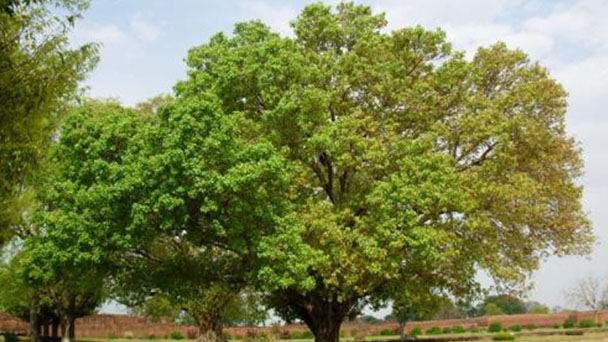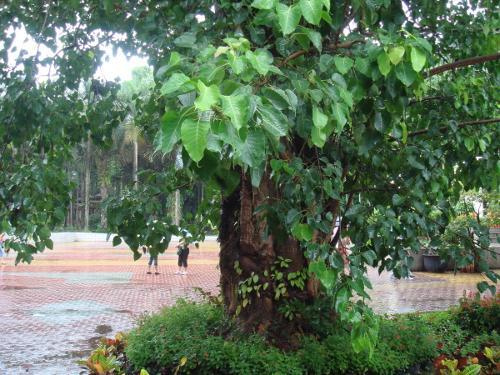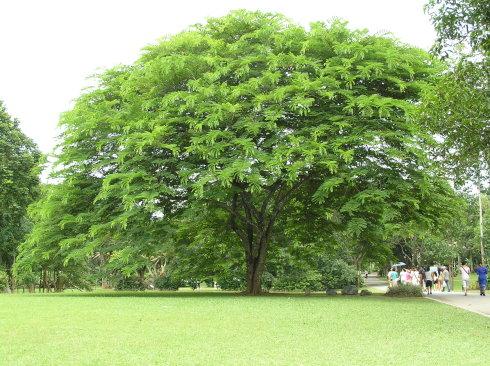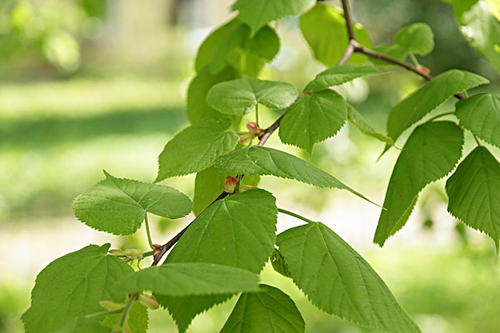Sacred fig profile
Written by Maggie
Oct 09 2021

Sacred fig has deep buddhist roots. One Sacred fig, formerly known in Sanskrit as Pippala, got its name from the Sacred fig (Buddhist Bodhivriksha), which means' enlightenment '. After the enlightenment of Buddha, the founder of Buddhism. Buddhism has always regarded Sacred fig as a tree, and it is widely planted in jungle temples in India, Sri Lanka and Myanmar, while India has designated it as the national tree.
Sacred fig picture
Morphological characteristics of Sacred fig
Sacred fig is a large tree that, when young, attaches to other trees. It is 15-25 meters high and has a DBH of 30-50 centimeters. The bark is gray, smooth or slightly longitudinally striated, crown width widely spreading; Branchlets are grayish brown, puberulent when young. Leaves are leathery, triangular-ovate, dark green, bright, abaxially green, apex cuspate, apically elongated, caudate, 2-5 cm long, base broadly truncate to shallow cordate, entire or undulate, basal veins trigonal, lateral veins 5-7 pairs; The petiole is slender, nodule, as long as or longer than leaf blade; sacred fig stipules are small, ovate, apex acute. Figs are globose to oblate globose, 1-1.5 cm in diameter, red when ripe, smooth; Sacred fig has 3 Bracts, basal, ovoid; Total stem length is ca. 4-9 mm; Male flowers, gall flowers and female flowers are on the same ficus inner wall; Male flowers are few, near mouth, sessile, perianth 2-3-lobed, inset, stamen 1, filaments short; Gall flowers are stipitate, perianth 3-4 lobed, ovary smooth, globose, style short, stigma swollen, 2-lobed; Female flowers are sessile, perianth 4, broadly lanceolate, ovary smooth, globose. Sacred fig style is slender, stigma narrow. Flowering period is March to April, and fruiting period is May to June.
Sacred fig growth habit
Sacred fig is an evergreen tree and a large tree, light - loving, shade - resistant, high - temperature, strong anti - pollution ability. The soil requirements are not strict, but with fertile, loose slightly acidic sandy loam better.
Sacred fig distribution area
Sacred fig is mostly cultivated in Guangdong (coastal islands), Guangxi, and Yunnan (north to Jingdong, at an altitude of 400-630 m). It is also cultivated in Japan, Malaysia, Thailand, Vietnam, Bhutan, Sikkim, Nepal, Pakistan and India, but wild in the Himalayas, from Rawalpindi, Pakistan to Bhutan.

Propagation methods of Sacred fig
Sowing: Generally using sand bed sowing. Before sowing with a small board a little compaction bed surface, bed surface leveling, the seeds are evenly spread on the bed surface. When sowing, we should avoid seeds that overlap into a small group, as far as possible to make each seed scattered on the bed surface. After sowing, cover the seeds with a thin layer of soil through a fine sieve. After sowing, use straw or a sunny net to set up a shade to reduce the moisture evaporation of the seedbed and keep the bed moist. The seeds of Sacred fig have no dormant habit and can germinate and be unearthed about 10 days after sowing.
Cutting: Select 8~ 15-year old healthy mother plants in spring or autumn, select the branches with full axillary buds from the mother plants, select the semi-lignified part of the cuttings about 15cm in length (about 0.5-0.8cm in diameter) for cutting propagation. The row spacing of the cuttings was 5cm×10cm, and the cutting depth was about 3cm. After the cutting was finished, the small bow canopy was set up, and white plastic was used. Cover the film and grow roots for about 10 days.
Main uses of Sacred fig
1. Sacred fig is thick and majestic, with canopy pavilions such as covers, which can be used as street trees;P otted seedling period is very ornamental value, often used to adorn the sitting room, study;
2. Leaf heart, the front of the long tail, in botany known as the "drip tip", very beautiful, made into a bookmark, can be moth proofing;
3. The stem is rich in white milk. After being taken out, hard gum can be made. Gargle with bark juice can cure toothache;
4. Flower medicine has the effect of sweating antipyretic, analgesic. Indians consider the leaves of Sacred fig to be effective against a variety of heart diseases;
6. In parts of India, Sri Lanka, and Myanmar, aerial roots are cut down to make feed for elephants.

Latest Updated
- Benefits of Bugleweed - 7 Science-backed Health Benefits
- Bugleweed Dangers & Side Effects - Is It Poisonous?
- How to Plant Evergreen Trees - What You Should Know
- When to Plant Evergreens - Grow Guide for Evergreen Trees
- 12 Wonderful Evergreen Shrubs for Your Garden
- 12 Popular Evergreen Plants with Pictures for Beginners
- When And How To Prune A Lilac Bush Like a Pro
- How to Grow & Care for Lilac Vine (Hardenbergia Violacea)
- Japanese Lilac Tree (Syringa Reticulata) Care & Propagation Guide
- Shumard Oak Pros and Cons - What to Know
Popular Articles
- Winter maintenance of Antirrhinum Majus
- How to Grow Terminalia Mantaly Tree
- How to Grow and Care for Crossostephium Chinense
- How to grow Antirrhinum Majus in spring
- Peristeria Elata (Dove Orchid) Profile: Info & Care Guide
- Underwatered Snake Plant (Sansevieria Trifasciata) - Signs And How To Fix
- How to Care for Brazilian Jasmine Plant (Mandevilla Sanderi)
- How to Grow & Care for Graptopetalum Purple Delight in Summer
- Rosa Chinensis (China Rose): Plant Growing & Care Tips
- How to Care for Baby Sun Rose (Aptenia Cordifolia)
